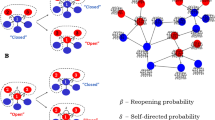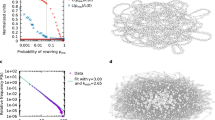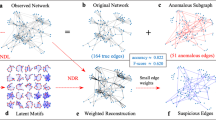Abstract
The microscopic principles organizing dynamic units in complex networks—from proteins to power generators—can be understood in terms of network ‘motifs’: small interconnection patterns that appear much more frequently in real networks than expected in random networks1,2. When considered as small subgraphs isolated from a large network, these motifs are more robust to parameter variations, easier to synchronize than other possible subgraphs, and can provide specific functionalities3,4,5,6,7,8,9,10,11,12,13,14,15. But one can isolate these subgraphs only by assuming, for example, a significant separation of timescales, and the origin of network motifs and their functionalities when embedded in larger networks remain unclear. Here we show that most motifs emerge from interconnection patterns that best exploit the intrinsic stability characteristics at different scales of interconnection, from simple nodes to whole modules. This functionality suggests an efficient mechanism to stably build complex systems by recursively interconnecting nodes and modules as motifs. We present direct evidence of this mechanism in several biological networks.
This is a preview of subscription content, access via your institution
Access options
Subscribe to this journal
Receive 12 print issues and online access
$259.00 per year
only $21.58 per issue
Buy this article
- Purchase on SpringerLink
- Instant access to full article PDF
Prices may be subject to local taxes which are calculated during checkout



Similar content being viewed by others
References
Milo, R. et al. Network motifs: Simple building blocks of complex networks. Science 298, 824–827 (2002).
Alon, U. Network motifs: Theory and experimental approaches. Nature Rev. Genetics 8, 450–461 (2007).
Mangan, S. & Alon, U. Structure and function of the feed-forward loop network motif. Proc. Natl Acad. Sci. USA 100, 11980–11985 (2003).
Mangan, S., Zaslaver, A. & Alon, U. The coherent feedforward loop serves as a sign-sensitive delay element in transcription networks. J. Mol. Biol. 334, 197–204 (2003).
Prill, R. J., Iglesias, P. A. & Levchenko, A. Dynamic properties of network motifs contribute to biological network organization. PLoS Biol. 3, e343 (2005).
Lodato, I., Boccaletti, S. & Latora, V. Synchronization properties of network motifs. Europhys. Lett. 78, 28001 (2007).
Ma, W., Trusina, A., El-Samad, H., Lim, W. A. & Tang, C. Defining network topologies that can achieve biochemical adaptation. Cell 138, 760–773 (2009).
Shoval, O. et al. Fold-change detection and scalar symmetry of sensory input fields. Proc. Natl Acad. Sci. USA 107, 15995–16000 (2010).
Rodrigo, G. & Elena, S. F. Structural discrimination of robustness in transcriptional feed-forward loops for pattern formation. PLoS ONE 6, e16904 (2011).
Wang, P., Lu, J. & Ogorzalek, M. J. Global relative parameter sensitivities of the feedforward loops in genetic networks. Neurocomputing 78, 155–165 (2012).
Hart, Y., Antebi, Y. E., Mayo, A. E., Friedman, N. & Alon, U. Design principles of cell circuits with paradoxical components. Proc. Natl Acad. Sci. USA 109, 8346–8351 (2012).
Genot, A. J., Fujii, T. & Rondelez, Y. Computing with competition in biochemical networks. Phys. Rev. Lett. 109, 208102 (2012).
Hart, Y. & Alon, U. The utility of paradoxical components in biological circuits. Mol. Cell 49, 213–221 (2013).
Hart, Y., Mayo, A. E., Shoval, O. & Alon, U. Comparing apples and oranges: Fold-change detection of multiple simultaneous inputs. PLoS ONE 8, e57455 (2013).
Adler, M., Mayo, A. & Alon, U. Logarithmic and power law input–output relations in sensory systems with fold-change detection. PLoS Comput. Biol. 10, e1003781 (2014).
Bernstein, N. A. The Co-ordination and Regulation of Movements (Pergamon Press, 1967).
Bizzi, E., Giszter, S. F., Loeb, E., Mussa-Ivaldi, F. A. & Saltiel, P. Modular organization of motor behavior in the frog’s spinal cord. Trends Neurosci. 18, 442–446 (1995).
LeDoux, J. The Emotional Brain: The Mysterious Underpinnings of Emotional Life (Simon and Schuster, 1998).
Kashtan, N. & Alon, U. Spontaneous evolution of modularity and network motifs. Proc. Natl Acad. Sci. USA 102, 13773–13778 (2005).
Slotine, J.-J. & Lohmiller, W. Modularity, evolution, and the binding problem: A view from stability theory. Neural Netw. 14, 137–145 (2001).
Allesina, S. & Tang, S. Stability criteria for complex ecosystems. Nature 483, 205–208 (2012).
Han, S. K., Kurrer, C. & Kuramoto, Y. Dephasing and bursting in coupled neural oscillators. Phys. Rev. Lett. 75, 3190–3193 (1995).
Campbell, S. & Wang, D. Synchronization and desynchronization in a network of locally coupled Wilson-Cowan oscillators. IEEE Trans. Neural Netw. 7, 541–554 (1996).
Nakao, H. & Mikhailov, A. S. Turing patterns in network-organized activator-inhibitor systems. Nature Phys. 6, 544–550 (2010).
Lohmiller, W. & Slotine, J.-J. E. On contraction analysis for non-linear systems. Automatica 34, 683–696 (1998).
Russo, G., di Bernardo, M. & Sontag, E. A contraction approach to the hierarchical analysis and design of networked systems. IEEE Trans. Autom. Control 58, 1328–1331 (2013).
Kashtan, N., Itzkovitz, S., Milo, R. & Alon, U. Topological generalizations of network motifs. Phys. Rev. E 70, 031909 (2004).
Simon, H. A. The architecture of complexity. Proc. Am. Phil. Soc. 106, 467–482 (1962).
Alon, U. Biological networks: The tinkerer as an engineer. Science 301, 1866–1867 (2003).
Itzkovitz, S. et al. Coarse-graining and self-dissimilarity of complex networks. Phys. Rev. E 71, 016127 (2005).
Acknowledgements
We thank A.-L. Barabási for valuable discussions. M.T.A. was supported by the CONACyT postdoctoral grant 207609, the ARL NS-CTA grant (W911NF-09-2-0053), and the DARPA grant (W911NF-12-C-002). Y.-Y.L. was supported in part by the John Templeton Foundation (award number 51977).
Author information
Authors and Affiliations
Contributions
All authors designed and did the research. M.T.A. analysed the empirical data and did the analytical and numerical calculations. M.T.A. and Y.-Y.L. wrote the manuscript. J.-J.S. edited the manuscript.
Corresponding authors
Ethics declarations
Competing interests
The authors declare no competing financial interests.
Supplementary information
Supplementary Information
Supplementary Information (PDF 10470 kb)
Rights and permissions
About this article
Cite this article
Angulo, M., Liu, YY. & Slotine, JJ. Network motifs emerge from interconnections that favour stability. Nature Phys 11, 848–852 (2015). https://doi.org/10.1038/nphys3402
Received:
Accepted:
Published:
Issue date:
DOI: https://doi.org/10.1038/nphys3402
This article is cited by
-
Time delays modulate the stability of complex ecosystems
Nature Ecology & Evolution (2023)



